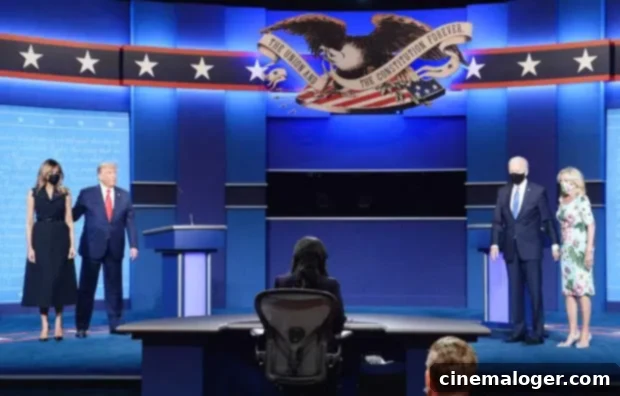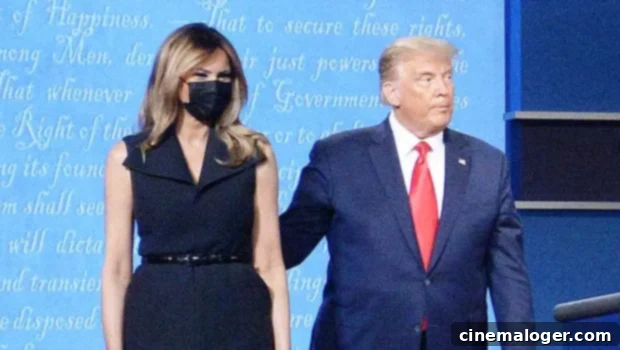Melania Trump’s Viral Debate Hand Snub: A Closer Look at Public Displays of Affection and Political Scrutiny
In the high-stakes world of presidential politics, every gesture, every interaction, and every moment in the public eye is meticulously scrutinized. Following the final presidential debate on October 22, one particular instance captivated social media and news outlets, drawing widespread attention: First Lady Melania Trump’s swift withdrawal of her hand from President Donald Trump as they exited the debate stage. This seemingly minor action quickly became a viral sensation, fueling discussions about political relationships, personal boundaries, and the relentless spotlight on public figures.
The night had been challenging for President Trump, following a vigorous exchange with then-candidate Joe Biden. As the debate concluded and the First Couple prepared to leave the stage, a moment intended for a united public appearance unfolded quite differently. While posing briefly for photographers, President Trump reached for his wife’s hand. In a blink-and-you’ll-miss-it motion, captured by various cameras, Melania Trump visibly and immediately yanked her hand away, a gesture that was interpreted by many as a clear sign of discomfort or detachment. The President’s subsequent, somewhat awkward, pat on her back as she walked ahead only amplified the perceived tension of the moment, leaving many observers to ponder the dynamics at play.
Melania yanks her hand away from Trump.
(Spotted by @WalnutDust) pic.twitter.com/NHDzoYfSuT
— The Recount (@therecount) October 23, 2020
This post-debate incident was not an isolated event but rather another chapter in a series of similar moments that have become a recurring feature of the Trump presidency. Over the years, countless videos and photographs have circulated, showing Melania Trump seemingly reluctant to engage in public displays of affection (PDA) with her husband. These instances range from subtle hand withdrawals to more pronounced swats away, often sparking intense speculation and discussion across social media platforms and news commentaries. A compilation video highlighting these moments even went viral in August, further cementing the public’s fascination with their dynamic. The consistent pattern raises questions about the couple’s private relationship, the pressures of public life, or perhaps a simple preference for personal space, all of which are vigorously debated by the public and media alike.
For example, earlier in the same day as the debate, the First Lady was observed holding hands with President Trump at Joint Base Andrews in Maryland, as they boarded Air Force One en route to Nashville. This contrasting behavior led many to believe that her later action on the debate stage was a deliberate choice or a reaction to the specific circumstances of the moment, rather than a general aversion to physical contact. The unpredictable nature of these interactions only adds to the intrigue, compelling observers to look for deeper meanings in every shared glance or touch, or lack thereof. Each occurrence reinforces the narrative that these aren’t merely accidental movements but potentially telling signs about the underlying relationship dynamics of the most powerful couple in the nation.
The Trumps’ interactions often stand in stark contrast to other political couples, most notably former Vice President Joe Biden and his wife, Dr. Jill Biden. The Bidens, who have shared a marriage spanning over four decades, frequently demonstrate overt affection in public, from warm embraces to walking hand-in-hand. Their public displays of unity and tenderness are often highlighted by the media as a symbol of stability and genuine connection, projecting an image of a supportive and affectionate partnership. This dichotomy between the two prominent political couples offers a compelling study in how different relationships are portrayed and perceived under the relentless glare of public scrutiny, influencing public perception and political narratives.
The October 22 presidential debate marked Melania Trump’s first major public appearance since her diagnosis with COVID-19 at the beginning of the month. While President Trump quickly returned to the campaign trail after testing negative, the First Lady had maintained a lower profile, focusing on her recovery at the White House with their son, Barron Trump, who also contracted the virus. Both Melania and Barron subsequently tested negative, allowing her to resume some public duties. Her presence at the debate, therefore, carried additional significance, as it signaled her return to the political spotlight after a period of illness and isolation, adding another layer of context to her actions on stage.

The persistent public fascination with Melania Trump’s body language and her apparent reluctance for PDA extends beyond a single debate. From the early days of the Trump administration, her seemingly reserved demeanor and infrequent displays of overt affection have been a constant topic of discussion. Memes, analytical essays, and casual conversations have all sought to decode her actions, often projecting various interpretations onto her gestures. Whether it’s a pull-away from Air Force One stairs or the infamous debate hand snub, each incident contributes to a growing narrative about her public persona and her relationship with the President.
Analysts of political body language often emphasize that such non-verbal cues can speak volumes, sometimes more eloquently than words. In the highly theatrical arena of American politics, where perception can often outweigh reality, the presentation of a united front is paramount for presidential couples. Any perceived crack in that facade, however subtle, can quickly become amplified, leading to widespread speculation and commentary. For Melania Trump, her consistent pattern of avoiding public physical intimacy has created a distinct public image that invites constant scrutiny and interpretation, distinguishing her from many of her predecessors and contemporaries.
Beyond the immediate viral moment, the incident serves as a reminder of the unique pressures faced by political spouses. Living under an unyielding microscope, every personal interaction becomes public domain, open to dissection and often misinterpretation. For the First Lady, navigating these expectations while maintaining personal boundaries and individuality can be an immense challenge. Her refusal to conform to traditional expectations of public displays of affection, whether driven by personal preference, a strategic decision, or simply the circumstances of the moment, has undoubtedly shaped her public identity and the ongoing narrative surrounding her role in the White House.
In conclusion, Melania Trump’s viral hand-yanking moment after the final presidential debate of 2020 was more than just a fleeting interaction; it was a snapshot that encapsulated numerous ongoing discussions about her public persona, the dynamics of political relationships, and the intense media scrutiny that accompanies life in the highest office. As observers continue to analyze every nuance of political couples, these small gestures will undoubtedly remain significant points of interest, offering windows into the complex interplay between public duty and private lives.
